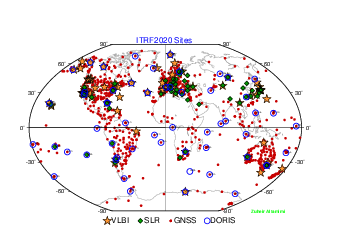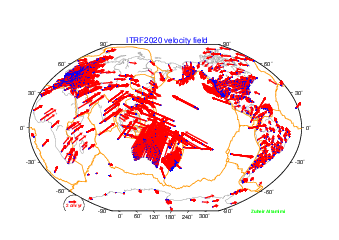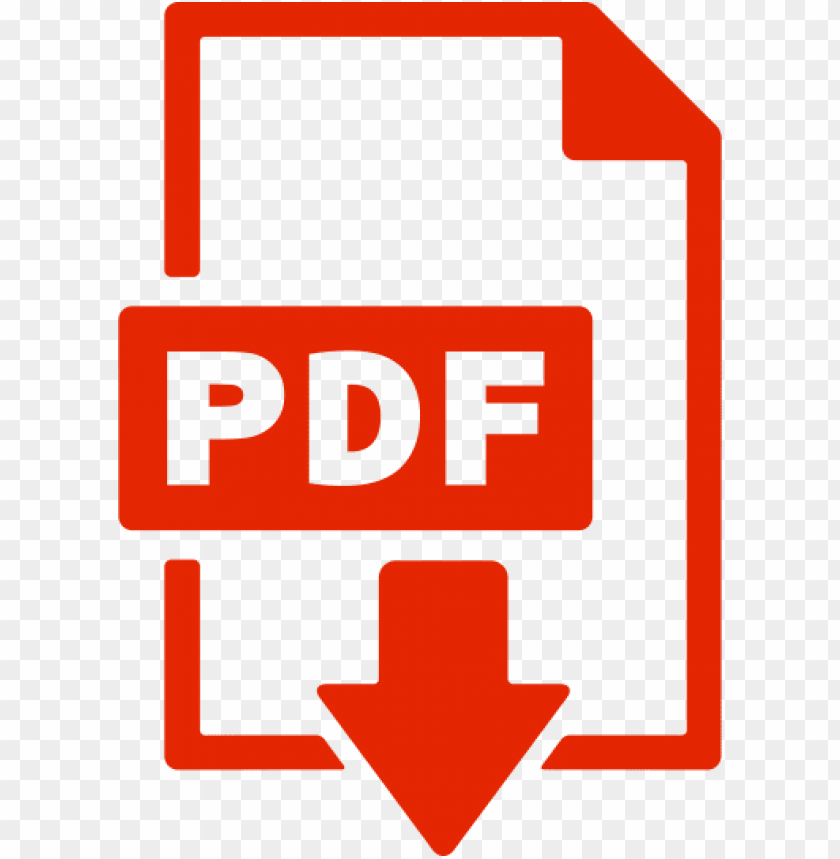April 2022
General Announcement
- The ITRF2020 is available online
Meeting Announcement
- Online seminars in Earth Tides and Geodynamics
Meetings Calendar
IAG Sponsored Meetings
- EUREF 2022 Symposium
- Spatial Data: science, research and technology 2022
- X Hotine-Marussi Symposium on Mathematical Geodesy
- IGS Workshop "IGS 2022: Science from Earth to Space"
- 2nd International Symposium of Commission 4: Positioning and Applications
- Gravity, Geoid and Height Systems 2022 (GGHS2022)
- REFAG 2022
- Unified Analysis Workshop on Laser Ranging
- 22nd International Workshop on Laser Ranging
- 20th Assembly of WEGENER
- GGOS Days 2022
IAG Related Meetings
- COSPAR 2022
General Announcement
The ITRF2020 is available online
a new realization of the International Terrestrial Reference System (ITRS)
The ITRS Center of the International Earth Rotation and Reference Systems (IERS), hosted by IGN France, in charge of the realization and maintenance of the ITRS has published a new version of the International Terrestrial Reference Frame (ITRF), called ITRF2020, on April 15, 2022.


What is the current rate of sea level rise in different regions of the globe? How does our Earth deform under the effect of plate tectonics, seismic phenomena, or the melting of ice caps? How the Earth’s center of mass is varying? How to determine the position of a point on the surface of a constantly deforming Earth and compare it to positions estimated decades apart? The answers to these fundamental questions for understanding the dynamics of our planet make it necessary to update the ITRF that is maintained by the ITRF research group at IGN and IPGP (Institut de Physique de Globe de Paris), and whose new release called ITRF2020 was published on April 15 and accessible here: https://itrf.ign.fr/en/solutions/ITRF2020.
The ITRF2020 brings significant improvements compared to previous achievements: it confirms the estimate of the position of the center of mass of the Earth as it was determined in 2016, but also provides its seasonal variations; it improves the accuracy of the scale of the frame at the millimeter level, which represents a gain in precision of a factor of 8 on the measurement of the size of the Earth (compared to that determined in 2016); it provides a precise quantification of co- and post-seismic displacements caused by, among others, devastating earthquakes, such as that of Chile in 2010 and Japan in 2011.
The stakes of ITRF in Earth science applications are considerable. It is the reference for precise orbits determination of the satellites which observe our planet; it is an essential standard for scientists, astronomers, geophysicists, climatologists around the world who study Earth’s deformations and variations. Finally, it is for all those passionate about geodesy or the evolution of our planet, an essential source of information.
I want to take this opportunity to acknowledge the enormous efforts of the IAG Services (IDS, IGS, ILRS, IVS) and their Analysis and Combination Centers for their contributions by providing reprocessed solutions. The quality of the ITRF2020 is certainly benefiting from these improved solutions. My deep thanks and acknowledgement go also to institutions hosting colocation sites, for their investment to global geodesy and for providing local survey results used in the ITRF2020 analysis.
The ITRF2020 is available at: https://itrf.ign.fr/en/solutions/ITRF2020.
Zuheir Altamimi
Head of the IERS ITRS Center
President of the International Association of Geodesy (IAG)
Meeting Announcement
Online seminars in Earth Tides and Geodynamics
We kindly invite you to a series of fortnightly seminars which shall be held online on the topics of Earth Tides and Geodynamics, the topic of the Sub-Commission SC 3.1 Earth Tides and Geodynamics, International Association of Geodesy (IAG) Commission 3 – Earth Rotation and Geodynamics. The seminars will be recorded, except for special demand of the presenter, and will be available for off-line.
The Zoom link to the seminars will be updated at every seminar.
The next seminars we have in program:
10 May 2022 1 PM CEST: Tommaso Pivetta, Gravity measurements as a useful tool to model Karst hydrology.
24 May 2022: visit EGU and Living Planet Symposium Earth Tides and Geodynamics related talks.
7 June 2022, 1 PM CEST: Alexandre Michel, GNSS inversion for surface loading
21 June 2022, 1 PM CEST: Isabelle Panet, Pre-seismic signals in GRACE gravity solutions: application to the 2011 Tohoku and 2010 Maule earthquakes
05 July 2022, 1 PM CEST: Anna Klos, Sensitivity of GPS technique for environmental loadings: implications for future estimates
The seminars will continue starting September 2022.
Time zone: CEST (Central European Summer Time) is UTC+2, which is 2h ahead of UTC (Coordinated Universal Time).
Those interested to share their work and give a seminar, are kindly asked to contact Carla Braitenberg (berg@units.it) or Severine Rosat (severine.rosat@unistra.fr). This invitation includes PhD and Master students, as well as PostDocs and senior scientists.
The Topics that are relevant to the Earth Tides and Geodynamics Commission take into account geodynamic phenomena on different temporal and spatial scales. These geodynamic phenomena can be observed by modern instrumentation and monitoring systems, both terrestrial and space-borne. The seminars will be open for a wide range of scientific problems in geodynamics research. Interactions of geophysical fluids with Earth tides phenomena and observations are a specific focus and includes:
- Tidal and non-tidal loading in space geodetic and subsurface observations
- Permanent and dynamic effects of Earth tides on the geodetic reference system
- Using tides and ocean tidal loading with modern geodesy to probe Earth structure
- Variations in Earth rotation, gravity field and geocenter due to mass redistributions
- Tidal forcing of plate movement
- Subsurface fluid movement through geodetic and gravity observation
- Fluid pressure changes due to Earth tides
- Stress and deformation changes due to injected fluids
- Earth tides, mass movements and deformation at volcanoes
- Tidal effects on geodetic satellites as GOCE, GRACE, …
- Innovations in instrumentation for gravity and deformation observation
- Innovations in software, data analyses and prediction methods of loading and tides
- Induced seismicity
- Tides and geodynamics in planets
Carla Braitenberg, University of Trieste
Severine Rosat, University of Strasbourg and CNRS.
Chair and co-chair of Sub-Commission SC 3.1 Earth Tides and Geodynamics, International Association of Geodesy (IAG)
Meetings Calendar
IAG Sponsored Meetings
- EUREF 2022 Symposium, June 1-4, 2022, Zagreb, Croatia URL: https://www.igs.org/event/euref-2022-symposium/
- Spatial Data: science, research and technology 2022, May 23 – 25, 2022, Moscow, Russia
URL: https://scidata.ru/en2022 - X. Hotine-Marussi Symposium on Mathematical Geodesy, June 13 – 17, 2022, Milan, Italy
URL: http://icct.kma.zcu.cz/index.php?title=Hotine-Marussi_2022 - IGS Workshop "IGS 2022: Science from Earth to Space", June 27-July 1, 2022, Boulder CO, USA
- URL: https://www.igscb.org/event/
- 2nd International Symposium of Commission 4: Positioning and Applications, September 5-9, 2022, Potsdam, Germany,
URL: https://iag-commission4-symposium2022.net/ - Gravity, Geoid, and Height Systems 2022 (GGHS2022), September 12-16, 2022, Austin TX, USA
URL: https://www.csr.utexas.edu/gghs2022/index.html - REFAG 2022, October 17-21, 2022, Thessaloniki, Greece
URL: https://www.refag2022.org/ - Unified Analysis Workshop (UAW) October 22-25, 2022, Thessaloniki, Greece
URL: https://ggos.org/event/unified-analysis-workshop-uaw-2022/ - 22nd International Workshop on Laser Ranging, October 31 – November 4, 2022, Kunming, China
- URL: http://22ndilrs2020.csp.escience.cn
- 20th Assembly of WEGENER, october 25-29, 2022, Marrakech, Morocco, URL: https://wegener2021.sciencesconf.org
IAG Related Meetings
- COSPAR 2022, July 16-24, 2022, Athens, Greece
- URL: https://www.cospar-assembly.org
Further details are available in the IAG Event Calendar at: http://www.iag-aig.org/events.
The IAG Newsletter is under the editorial responsibility of the Communication and Outreach Branch (COB) of the IAG. It is an open forum and contributors are welcome to send material (preferably in electronic form) to the IAG COB (newsletter@iag-aig.org). These contributions should complement information sent by IAG officials or by IAG symposia organizers (reports and announcements). The IAG Newsletter is published monthly. It is available in different formats from the IAG new internet site: http://www.iag-aig.org.
Each IAG Newsletter includes several of the following topics:
- news from the Bureau Members
- general information
- reports of IAG symposia
- reports by commissions, special commissions or study groups
- symposia announcements
- book reviews
- fast bibliography
| DOCUMENTS |
| IAG_Newsletter_April_2022.pdf |
